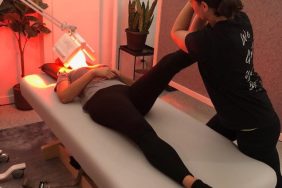
Read on to find out why you might want to stop avoiding those pushups and squats…
-
Cardinal rule: Always work within a pain-free range of motion.
This is especially important when you are returning from an injury. Since exercise can promote healing by 50%, the most critical thing is to not re-injure yourself. Don’t make the mistake of not backing off when you’re on the road to recovery – in particular, you should start with smaller-scale goals than you had before the injury and only gradually build up to the level you had achieved.
-
Limit the amount of tension you place on your joints.
With resistive exercise (lifting weights or universal equipment), work within the mid-range of the joint’s movement. Most strains occur when the body is working the movement from the end-range of the joint. For example, when doing a squat, in order to not create too much force on your knee, have a bench behind you to limit how far down you go.
-
Warm up, warm up, warm up.
Make sure you give the body a proper warm-up when starting your exercise routine – and this does not involve stretching (that’s for the end of the workout). A good warm-up would be doing the movements you’re going to stress in the workout, but with little to no resistance. For example, if you’re going to do a squat movement, do that movement first with no weight for two sets, the first set with an even, slow-to-moderate speed, and the second at a pace double that of the first set.
-
If you’re a couch potato or recovering from a significant injury to your lower to mid-back, go for planks.
When using a plank, you’re in a static position and it’s an exercise that can be done with various levels of difficulty – for example, movements can be done on the floor, or using a balance ball. The benefits from using planks derive from the nerve stimulus to the area — that is, any muscles that are under-stimulated will quickly receive a higher level of stimulation. Working on planks is a vitally important step on the road to a healthy back.
-
Joints only like to work within a certain range of their neutral position.
When doing any type of exercise movement (ranging from running to the biceps curl), you should be aware of a concept called nutation. This term refers to the center movement about a joint. Joints like to work within a certain range of their most neutral position and to move around that center point in as balanced a way as possible. Only when this “biomechanical balance” is occurring do the muscles work in their most effective manner, greatly reducing the risk of injury.
-
Get familiar with the free-standing squat.
Patients often ask me which exercise provides the greatest overall benefit to the body and my answer is always the free-standing squat. However, it is imperative that you learn how to do this movement properly, and this requires understanding the concept called the kinetic chain. What does this mean? In layman’s terms, it is best understood as the sequence of movements of all your weight-bearing joints from the ground up – that is, the proper balance of movement from the ankle to the knee to the hip to the lumbar spine. Performing free-standing squats regularly increases the body’s overall strength … and will keep you walking briskly throughout your whole life.
-
Doing push-ups can help prevent injury.
Studies have shown that people who regularly do push-ups lower the risk of debilitating injuries that may occur, such as falls later in life. After all, isn’t it logical that if you’re able to do push-ups, you’ll be strong enough to catch yourself and better support yourself from the shock of a fall?




